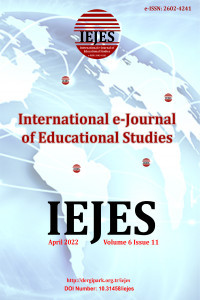Character Education Human Nature Based-Curriculum in Science Learning of Primary School
Dioramas are seen as unique teaching tools for environmental education in general and biodiversity education in particular as they present realistic learning environments that can reflect the components of the biodiversity, relationships among these components and changes occur over time. The aim of this study is to examine middle school students' views on diorama supported biodiversity education. A phenomenological approach based on student experiences were employed for the study. The study group of the research consists of twenty-four 7th grade students studying during the 2021-2022 academic year. Students participated in an 8 hours experimental process included diorama supported 5E constructivist teaching model. Interviews were used as the data collection tool. The analysis of data revealed that dioramas contribute positively to biodiversity education as they enhance learning, mitigate the effects of misconceptions, increase students’ awareness to protect biodiversity and of biodiversity sustainability. Therefore, including and using dioramas in learning environments for biodiversity education can mediate learning as well as help students to benefit from a realistic environment that include living things, the ecosystems they form and the places they live in.
Anahtar Kelimeler:
Curriculum, character, human nature, physics
Character Education Human Nature Based-Curriculum in Science Learning of Primary School
Dioramas are seen as unique teaching tools for environmental education in general and biodiversity education in particular as they present realistic learning environments that can reflect the components of the biodiversity, relationships among these components and changes occur over time. The aim of this study is to examine middle school students' views on diorama supported biodiversity education. A phenomenological approach based on student experiences were employed for the study. The study group of the research consists of twenty-four 7th grade students studying during the 2021-2022 academic year. Students participated in an 8 hours experimental process included diorama supported 5E constructivist teaching model. Interviews were used as the data collection tool. The analysis of data revealed that dioramas contribute positively to biodiversity education as they enhance learning, mitigate the effects of misconceptions, increase students’ awareness to protect biodiversity and of biodiversity sustainability. Therefore, including and using dioramas in learning environments for biodiversity education can mediate learning as well as help students to benefit from a realistic environment that include living things, the ecosystems they form and the places they live in.
Keywords:
Curriculum, character, human nature, physics,
___
- Abdulloh Hamid. (2017). Pendidikan karakter berbasis pesantren (Pelajar dan Santri dalam Era IT & Cyber Culture) (Kedua). Imtiyaz.
- Akbar, S. (2011). Revitalisasi pendidikan karakter di sekolah dasar. Universitas Negeri Malang.
- Al Nahlawi, A. (1996). Prinsip-prinsip dan metode pendidikan islam dalam keluarga, di sekolah dan Masyarakat. Diponegoro.
- Arif, R. M. (2017). Implementasi pendidikan karakter dalam pembelajaran sains. STILISTIKA: Jurnal Bahasa, Sastra, Dan Pengajarannya, 2(1), 314-324. https://doi.org/10.33654/sti.v2i1.385
- Bhat, A. M. (2016). Human psychology (fitrah) from islamic perspective. International Journal of Nusantara Islam, 4(2), 61-74. https://doi.org/10.15575/ijni.v4i2.1187
- Fatimah, S., & Kartika, I. (2013). Pembelajaran ipa sekolah dasar berbasis pendidikan karakter. Jurnal Al-Bidayah, 5(2), 281-297. https://jurnal.albidayah.id/index.php/home/article/view/125
- H.M. Arifin. (2019). Ilmu pendidikan islam-tinjauan teoritis dan praktis berdasarkan pendekatan interdisipliner (Ke-8). PT Bumi Aksara.
- Hairuddin. (2013). Pendidikan karakter berbasis sunnah nabi. Jurnal Al-Ulum, 13(1), 167–190.
- Hamid, H. (2012). Pengembangan kurikulum pendidikan (ke-1). cv.pustaka setia.
- Judiani, S. (2010). Implementasi program penguatan pendidikan karakter di sekolah dasar melalui penguatan pelaksanaan kurikulum. Jurnal Pendidikan Dan Kebudayaan, 16, 280. https://doi.org/10.26858/pir.v3i2.14971
- Khoiri, A., Agussuryani, Q., & Hartini, P. (2017). Penumbuhan karakter islami melalui pembelajaran fisika berbasis integrasi sains-islam. Tadris: Jurnal Keguruan Dan Ilmu Tarbiyah, 2(1), 19-31. https://doi.org/10.24042/tadris.v2i1.1735
- Mansir, F. (2021). Aktualisasi pendidikan agama dan sains dalam character building peserta didik di sekolah dan madrasah. J-PAI: Jurnal Pendidikan Agama Islam, 7(2), 87–93. https://doi.org/10.18860/jpai.v7i2.11704
- Marzuki. (2015). Pendidikan karakter Islam (N. L. Nusroh (ed.); Pertama). AMZAH.
- Muhamad Mustaqim. (2015). Model pendidikan karakter terintegrasi pada pembelajaran di pendidikan dasar. STAIN Kudus.
- Muliati, I. (2017). Konsep fitrah dan implikasinya dalam pendidikan. In Universitas Negeri Padang 5 (2), 223. Universitas Negeri Padang. https://doi.org/10.31942/pgrs.v5i2.2611
- Muluk, H. (2019). Kacau, Pendidikan Dasar Kita Lebih Banyak Akademiknya Daripada Nilai Budi Pekerti. Sekolahdasar.Net. https://www.sekolahdasar.net/2019/02/kacau-pendidikan-dasar-kita-lebih-banyak-akademiknya.html
- Mundilarto. (2003). Membangun karakter melalui pembelajaran sains. Jurnal Pendidikan Karakter, 20, 153-163.
- Purnama, S., Aziz, H., Nurhusna, L., & Ulfah, M. (2020). The concept of fitrah for children in ıbn katsir’s qur’an exegesis: a pedagogical implication in early childhood islamic education. Jurnal Pendidikan Islam, 9(1), 79–104. https://doi.org/10.14421/jpi.2020.91.79-104
- Putra, P. (2017). Implementasi pendidikan karakter dalam pembelajaran ıpa di mın pemangkat kabupaten sambas kalimantan barat. JIP: Jurnal Ilmiah PGMI, 3(1), 49–61. https://doi.org/10.19109/jip.v3i1.1377
- Rasyid, A. N., Alifah, I. N., & Fajar, D. M. (2019). Optimalisasi pendidikan karakter melalui pembelajaran ipa terpadu. IAIN Jember, 173-190. http://digilib.iain-jember.ac.id/1709/3/Buku IPA-185-202.pdf
- Suriadi, S. (2019). Fitrah dalam perspektif al-quran (kajian terhadap ayat-ayat al-quran). Muaddib : Studi Kependidikan Dan Keislaman, 8(2), 143. https://doi.org/10.24269/muaddib.v8i2.1424
- Syahri, A. (2019). Pendidikan karkter berbasis sistem İslamic boarding school (Pertama). CV. Literasi Nusantara.
- Syarbini, A. (2016). Pendidikan karakter berbasis keluarga (Pertama). Ar-Ruzz Media.
- Triwidyastuti, T., & Siregar, M. (2018). The concept of islamic education development based on the theory of Fitrah. Indonesian Journal of Interdisciplinary Islamic Studies, 2(1), 31–52. https://doi.org/10.20885/ijiis.vol2.iss1.art2
- Widayanti, E. W. S. D. (2018). Penguatan pendidikan karakter berbasis religius. CIASTECH, 5(2). https://doi.org/10.31479/citra.v5i2.28
- Yahya, K. (2010). Pendidikan karakter berbasis potensi diri. Pelangi Publishing.
- Zed, M. (2008). Metode penelitian kepustakaan. Obor.
- Başlangıç: 2017
- Yayıncı: Tamer KUTLUCA
Sayıdaki Diğer Makaleler
Exploring Teacher Knowledge in Natural Sciences
Thuli Gladys NTULİ, Tebogo NKANYANİ, Lettah SİKHOSANA, Awelani V MUDAU
Comparison of 5th to 8th Grade Mathematics Curricula in Turkey and Greece
Enta ISMAIL AMET, Gül KALELİ YILMAZ
Agrippa Madoda DWANGU, Vimbi MAHLANGU
Social Issues on the Academic Performance of Secondary School Learners in the Limpopo Province
Liliian WHYLKEN, Alfred MODİSE, Sepeng PERCY
Kentse LEGODİ-RAKGALAKANE, Matsolo MOKHAMPANYANE
The Difficulties and Educational Stress of Nursing Students in Clinical Practice during the Covid
Esma AKGÜL, Canan BİRİMOĞLU OKUYAN, Filiz POLAT
Management of Students in Islamic Boarding Schools
